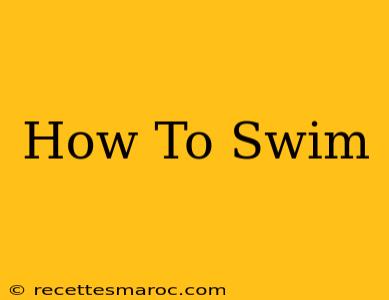So you want to learn how to swim? That's fantastic! Swimming is a fantastic full-body workout, a life-saving skill, and a ton of fun. This guide will walk you through the basics, from getting comfortable in the water to mastering different strokes. Remember, safety is paramount, so always swim with a buddy or in a supervised area.
Getting Comfortable in the Water
Before you start learning strokes, you need to feel comfortable in the water. This involves overcoming any fear and getting used to the sensation of floating and moving.
1. Getting Used to the Water Temperature
Start by slowly entering the water, allowing your body to adjust to the temperature. Don't jump in cold! Submerge yourself gradually, getting used to the feeling of the water on your skin.
2. Blowing Bubbles
Practice blowing bubbles underwater. This helps you get comfortable with putting your face in the water and exhaling, a crucial skill for swimming. Try to blow slow, steady streams of bubbles.
3. Kicking
Hold onto the side of the pool and practice kicking your legs. Keep your legs straight and kick from your hips, not your knees. Focus on a steady, rhythmic motion.
4. Floating
Try floating on your back. Relax your body and let the water support you. This helps you build confidence and understand buoyancy. You can also try floating on your stomach, but this is generally more difficult for beginners.
Learning Basic Strokes
Once you're comfortable in the water, it's time to learn some basic strokes. We'll focus on the freestyle (crawl) and backstroke, which are generally the easiest for beginners.
1. Freestyle (Crawl)
- Body Position: Maintain a streamlined body position, keeping your body as straight as possible.
- Kicking: Continue the leg kicks you practiced earlier, aiming for a powerful and consistent motion.
- Arm Strokes: Alternate your arm strokes, pulling water towards you with each stroke. Your arms should recover above the water.
- Breathing: Breathe by turning your head to the side to take a breath and then exhaling underwater. Coordinate your breathing with your arm strokes.
2. Backstroke
- Body Position: Lie on your back, keeping your body straight and relaxed.
- Kicking: Use the same kicking technique as the freestyle, keeping your legs straight and kicking from your hips.
- Arm Strokes: Extend your arms above your head and then pull them back down through the water, sweeping them out wide.
- Breathing: Breathing is generally easier in backstroke as your face is already above water.
Important Considerations
- Practice Regularly: Consistent practice is key to improving your swimming skills. Even short, regular sessions will make a big difference.
- Find a Qualified Instructor: Consider taking lessons from a certified swimming instructor. They can provide personalized guidance and feedback.
- Safety First: Always swim with a buddy, especially when you are a beginner. Never swim alone.
- Listen to Your Body: Don't push yourself too hard, especially when you are starting. Take breaks when needed and stop if you feel tired or unwell.
Learning to swim takes time and patience. Don't get discouraged if you don't get it right away. Keep practicing, and you'll be enjoying the water in no time! Remember to have fun and enjoy the process of learning this valuable life skill.

